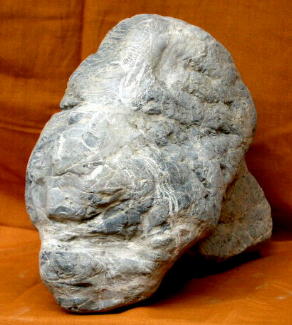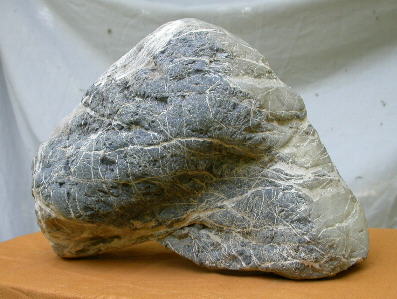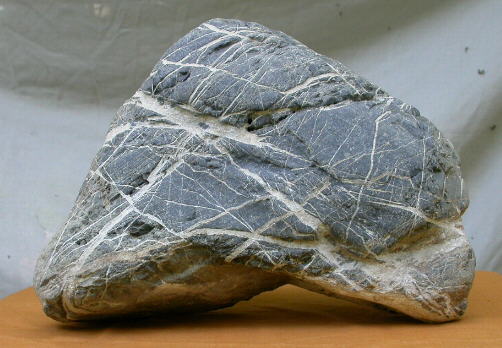PALEOLITHIC ART MAGAZINE
LIGURIA
A HUMAN PORTRAIT CARVED 200,000 YEARS AGO DESCRIBED BY THE TEACHING METHODOLOGY OF THE ARCHEOARTEOLOGY
Pietro Gaietto
Director of the website of the Museum of the Origins of Man
Genova, Italy, November, 24 2002
- Two accidental discoveries.
- The concept of portrait.
- The anthropomorphic sculpture and the paleoanthropology.
- Description of the sculpture of Borzonasca.
- The photographs of the sculpture of Borzonasca.
- The characteristics of the authenticity.
- The spiritual life.
The sculpture here introduced is particularly beloved by me, not only why it is the sculpted portrait more ancient that I know, but also why it has been discovered two times: the first time by me, and the second time by my wife Licia, a few months later, when she photographed it and discovered the portrait.

LOWER PALEOLITHIC SCULPTURE OF BORZONASCA
Beardless human head
TWO ACCIDENTAL DISCOVERIES
Borzonasca, Province of Genova (Italy), is a town known for the "megalithic Face of Borzone", a mountain rock sculpture.
I was on my way to the Rocche of Borzone, as I do every year, to see the "Megalithic Face", when I noted, in a space at the edge of the road, a truck discharging a load of gravel from the stream Penna below. These stones were brought in for construction work.
As my habit in 45 years of research, I stopped to check if in the pile of stones there were "traces of prehistory", what every archaeologist does, or should do , as generally these inspections of material from archaeological areas can, even through fragments, suggest the presence of archaeological deposits in the area.
The stones, mostly of small dimension, were flowed, therefore every possible tool had gone destroyed, becoming a small pebble; infact the type of stone of the zone, lacking the silex, is easy deperible. Between these stones, a greater stone, exactly that one that here I introduce, has seemed to me immediately, for how much still covered of earth, a two-faced anthropomorphic sculpture; not having never made researches in zone, I have taken it like evidence in order to return subsequently, without not even watching it carefully because it is a type enough common.
In the prehistoric mountain places, every artefact, generally, is transported from alluviums to the valley, where it is easier to find the remains of it in the small torrents.
By typology I have attributed this sculpture to the final phase of the lower Paleolithic, interpreting it, while I collected it, only for the lateral views (Fig. 4 and 7).
If I hadn't picked it up it would have gone into the cement to build a wall.
The second discovery, also this casual, is due to my wife Licia: hearing her exclaim: "Exceptional!", and not understanding well what she was referring to, I have reached her quickly, and she has explained me to have seen a beardless human head frontally (Fig. 3).
I was touched, since, between Paleolithic sculptures, this is the greatest portrait "intentionally" sculpted known by me, and also the most ancient.
THE CONCEPT OF PORTRAIT.
In the art of every time, the representation of the head can be or not a portrait, like in the case of a head represented in geometric style.
The portrait can be "intentional" or "physiognomic". The "intentional" portrait is diffused in the art of all the times and everywhere in the world; as an example, near the Aegyptians, the portrait always has been "intentional".
The "physiognomic" portrait, allowing to recognize individually the portrayed person, from the prehistory to our days, is extremely rare. We find the "physiognomic" portrait only near the Greeks, where it was rare; near the Romans, where, for a short time, it had a keen favor; in the Middle Age in Europe it is present, not in the religious art, but in the funeral sculpture, and finally, with the Renaissance, in Europe, it begins to being frequent.
The portrait of the sculpture of Borzonasca is an "intentional" portrait very important, in how much pertaining to paleoanthropology, although paleoanthropologists may not care.
THE ANTHROPOMORPHIC SCULPTURE AND THE PALEOANTHROPOLOGY
The findings of human skulls, dating from 400.000 to 150.000 years, are all made up of fragments. A complete skull has not yet been found. These fragments, at first attributed to Homo erectus, at present, in part, are attributed to archaic Homo sapiens.
Of these men, in great part, we still do not know who had an acheulean material culture (industry with bifaces), and who a clactonian material culture (industry on flake).
The anthropomorphic sculptures of the lower Paleolithic, of every type, but in particular those like this of Borzonasca, that are "intentional" portraits, should be object of study from the paleoanthropologists, as the data that can be found are numerous. In fact, on one side there are the fragments of skull and their reconstructions, while on the other side, with the sculptures of human heads, there are images produced by the prehistoric man, which are equivalent to photographs, which, even if vaguely deformed, always supply indications on the anatomical features. The investigation, in every discipline, must be made on every possible field.
DESCRIPTION OF THE BORZONASCA SCULPTURE
The sculpture represents two human heads joined for the nape (Fig. 4 lateral A and B, Fig. 7 lateral B and A), one beardless (Fig. 1, 2, 3, side A) and the other bearded (Fig.6 side B).
The beardless head has receding forehead, and a much enlarged beard (the description of another bearded head can be found in this magazine: "intentional" portrait.
The bearded head has only partially represented the features of the face; it has forehead absence, i.e. escaping forehead, and a very wide beard (see the description of an other bearded head in this magazine: "A bicephalic anthropomorphic lithic sculpture of the lower Paleolithic of Denmark",P.Gaietto). The eye of the bearded head consists of a linear incision in the broad white vein of the stone (Fig. 7 side B), from which the receding forehead departs, ending pointedly at the junction of the nape with the beardless head.
Size: 29 cm. lenght, 21 cm. eight, max 14 cm. wide, hollow under the jaws max 3,5 cm. height.
The attribution to the material culture is the final lower Paleolithic, but not still established if final Acheulean or final Clactonian, in how much no associated industries were found.
The relative dating, inferred from the attribution of the material culture, is comprised between 400,000 and 200,000 years. The beardless head could be a female head, while the bearded is a male.
THE PHOTOGRAPHS OF THE BORZONASCA SCULPTURE
The sculpture is photographed in eight consecutive views from left to right.

Fig. 1) Lower Paleolithic sculpture of Borzonasca
Beardless human head
Frontal view side A

Fig. 2) Lower Paleolithic sculpture of Borzonasca
Beardless human head
Semifrontal right view side A

Fig. 3) Lower Paleolithic sculpture of Borzonasca
Beardless human head
Semifrontal left view side A
and on the back head part side B

Fig. 4) Lower Paleolithic sculpture of Borzonasca
Two human heads joined for the nape,
lateral view A and B, beardless human head side A,
bearded human head side B

Fig. 5) Lower Paleolithic sculpture of Borzonasca
Bearded human head,
Semifrontal right view side B
and on the back beardless head part side A

Fig. 6) Lower Paleolithic sculpture of Borzonasca
Bearded human head,
frontal view side B
and on the back on the left beardless head part side A

Fig. 7) Lower Paleolithic sculpture of Borzonasca
Two human heads joined for the nape,
on the left bearded human head side B,
On the right beardless human head side A

Fig. 8) Lower Paleolithic sculpture of Borzonasca
on the right semifrontal view of the beardless head side A
on the back bearded head part side B
THE CHARACTERISTICS OF THE AUTHENTICITY
In the mail related to the site of the Museum of the Origins of Man, publishing mainly sculpture of the lower and middle Paleolithic, I periodically receive mails from people questioning themselves on the ways to determine the authenticity of these lithic sculptures, and they could do it also for this one of Borzonasca. I answer this question by pointing out that, until archaeoarteology will not be operating, with new scholars doing their own research, and also discussing the existing finds, with the contribution of new opinions, this state of uncertainty and generalized doubt will continue to exist.
I must remember that, until today, the palethnology has turned its researches mainly to the material culture, and never to the sculpture of the lower and middle Paleolithic. Moreover, the little discoveries of sculptures of the lower Paleolithic, found in sites in which the absolute dating has been possible, even if studied by important paleoanthropologists and palethnologists, have not given impulse to the research, as received by the scientific world with indifference. Therefore, these important studies have gone into oblivion, but we hope that others will not go there.
The sculpture of Borzonasca is the typical bicephalic anthropomorphic sculpture of the final phase of the lower Paleolithic, that is the final Acheulean or perhaps the final Clactonian, also called evolued. It is a typology that has been found abundantly in smaller flint sculptures, having techniques of working and patina in all similar to tools in flint, with which have been found associated, and of which it is possible the dating for typology.
In this sculpture of Borzonasca the working is deduced from the modeling, and, in spite of the light damage from flowing, are visible traces of removal of the material, which, in photograph are visible in the bearded face (fig. 6 right side); these traces are vertical carvings from strikings.
The white color of the stone veins does not affect the representation.
SPIRITUAL LIFE
The function of the sculpture is in the cult rituals, in relation to which are few also the hypotheses, and of which I have treated more times in my writings, and therefore for this sculpture is worth how much said for other sculptures of this cultural phase.
The bearded head (Fig. 6 left side) has under the forehead a carved triangle in relief of 2 cm each side, placed in the orbital area, as it was an eye. The triangle is perfect. I realized this now while describing it. It is amazing. I will continue to study it and report the conclusions, if there will be any. I was not ready to find a symbol in such an ancient era. My only idea is that this triangle is a symbol, but at the moment I have no idea about what that symbol might be.
Index
HOME PAGE
Copyright©2000-2002 by Paleolithic Art Magazine, all rights reserved.









